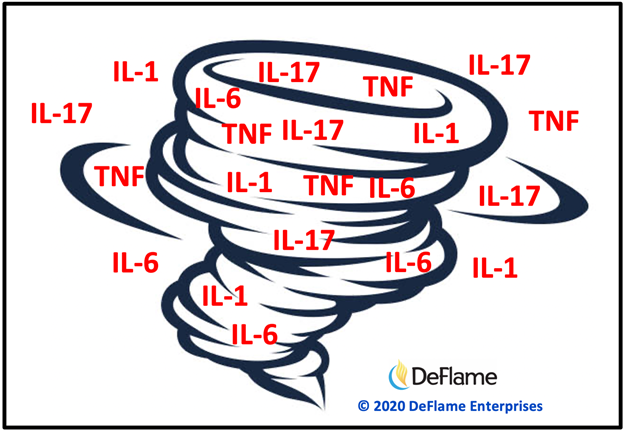Avoid the lethal COVID Cytokine Storm
The term “cytokine storm” emerged in news in the context of those people who developed a severe case of COVID-19 and required hospitalization. I learned a fair amount about cytokines long before 2020, but I had not read about the cytokine storm until COVID-19 emerged. In fact, the term cytokine storm has been used previously in the context of the seasonal flu as made evident in the title of this 2016 article:
Lieu Q, Zhou Y, Yan Z. The cytokine storm of severe influenza and development of immunomodulatory therapy. Cell Mol Immunol. 2016;13(1):3-10.
Cytokine is the name given to a family several dozen proteins, the most notable group are called interleukins, of which there are over 30. Most cytokines are pro-inflammatory, such as interleukin-1 (IL-1), interleukin-6 (IL-6), interleukin-17 (IL-17), and tumor necrosis factor (TNF).

Cytokines are released by cells when they stressed. After the stressor resolves, cytokine levels are supposed to go back to normal. A cytokine storm should never emerge, wherein an excessive amount of cytokines are released that subsequently damaged the body or lead to death.
In “storm language,” a cloudy drizzly day can be likened to “catching a cold” and feeling under the weather for a few days. The cold symptoms were created by a mild elevation in the production of cytokines and other inflammatory chemicals. In contrast, a cytokine storm is like a tornado or hurricane that rips a town apart, causing death and destruction.
Cytokines are released by multiple cell types, but were first identified to be released by immune cells called leukocytes, which is how the word interleukin came to be. Cytokines are released in excess in response to stressful events that are overtly traumatic such as a bee sting, spraining a joint, or an infection. The redness, heat, swelling, fever, and pain that results from these traumatic events are caused by cytokines and other pro-inflammatory chemicals.
Over the last 20 years, scientists discovered that overt trauma is not necessary to cause cells to increase their release of cytokines at sustained chronic low level. Chronic mental/emotional stressors events, sedentary living, chronic sleep loss, and a pro-inflammatory diet can cause cells to release an excess of cytokines. Even minor acute stressful events can cause cytokine release, such as eating several donuts in one sitting or missing a night’s sleep. We should view these as low-grade cumulative stressors, as indicated in the following image.

Most people who suffer from too many years of exposure to chronic stressors and the subsequent chronic inflammation will likely develop a chronic inflammatory disease, such as cancer, diabetes, depression, hypertension, heart disease, Alzheimer’s disease and/or other chronic diseases. It is important to understand that these various diseases manifest because people are chronically living in an elevated cytokine state. So, it should not be surprising that when some of these people are infected by a virus, they will suffer a lethal cytokine storm.
While it is possible to measure blood levels of cytokines, it is not a common practice in the clinical setting and they are expensive to measure. A pro-inflammatory protein called high sensitivity C-reactive protein (CRP) is the best option as it is inexpensive and its levels rise along with cytokines, so it mirrors cytokine production. A normal level of CRP is less than 1 mg/L. Between 1 and 3 mg/L is considered to reflect mild inflammation. The average middle-aged American has a CRP of 1.5 mg/L. It is estimated that 25% of the US population have CRP levels over 3 mg/L, which reflects a state of moderate to high inflammation. The higher the CRP level, the worse the outcome will typically be if some is injured or infected.
The practical DeFlame message of this blog is… A normal CRP level below 1 mg/L suggests that cytokine levels are also normal. The goal should be to DeFlame the diet and lifestyle to the degree that CRP levels drop below 1 mg/L. This is an especially uncomplicated approach to health promotion and disease prevention and will essentially guarantee that a cold, flu, or coronavirus infection will be a mild to an annoying experience rather than a life threatening event.



